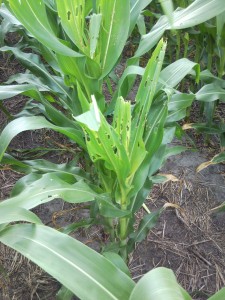Scouting for Whorl Feeding Insects
go.ncsu.edu/readext?898528
en Español / em Português
El inglés es el idioma de control de esta página. En la medida en que haya algún conflicto entre la traducción al inglés y la traducción, el inglés prevalece.
Al hacer clic en el enlace de traducción se activa un servicio de traducción gratuito para convertir la página al español. Al igual que con cualquier traducción por Internet, la conversión no es sensible al contexto y puede que no traduzca el texto en su significado original. NC State Extension no garantiza la exactitud del texto traducido. Por favor, tenga en cuenta que algunas aplicaciones y/o servicios pueden no funcionar como se espera cuando se traducen.
Português
Inglês é o idioma de controle desta página. Na medida que haja algum conflito entre o texto original em Inglês e a tradução, o Inglês prevalece.
Ao clicar no link de tradução, um serviço gratuito de tradução será ativado para converter a página para o Português. Como em qualquer tradução pela internet, a conversão não é sensivel ao contexto e pode não ocorrer a tradução para o significado orginal. O serviço de Extensão da Carolina do Norte (NC State Extension) não garante a exatidão do texto traduzido. Por favor, observe que algumas funções ou serviços podem não funcionar como esperado após a tradução.
English
English is the controlling language of this page. To the extent there is any conflict between the English text and the translation, English controls.
Clicking on the translation link activates a free translation service to convert the page to Spanish. As with any Internet translation, the conversion is not context-sensitive and may not translate the text to its original meaning. NC State Extension does not guarantee the accuracy of the translated text. Please note that some applications and/or services may not function as expected when translated.
Collapse ▲Corn earworm, fall armyworm, first generation European corn borer (present in non-Bt refuge corn), and several minor pests can be evaluated using this procedure. Emphasis should be placed on scouting plants when caterpillars are small. This implies that only minor foliage feeding signs will be present although infestation may be high. Damage will be expressed as leaf surface feeding, window-paning, edge feeding, and small holes eaten through the leaves. Caterpillars will typically be found within the loosely furled leaves.
Sampling Pattern and Procedure. Enter the field at least 50 paces and take the required samples (one sample per 2 acres of field size, minimum of 4 samples and maximum of 10 samples). Travel a “U” shaped or “zigzag” pattern through the field. Avoid weak spots and take only one sample on a given row. Examine 10 consecutive plants per sample for damage in the whorl. On the last 2 damaged plants per sample (if there are damaged plants), pull the whorl from the plant and count the caterpillars while unrolling the leaves. Record the number of plants showing caterpillar feeding and the number of worms per 2 plants after each sample. When all samples are taken determine the following:
Calculate the percent damaged plants by dividing the total number of damaged plants by total number of plants examined and multiply by 100.
Calculate the average number of caterpillars per damaged plant by dividing the total number of caterpillars found by the number of plants examined. These two figures are then multiplied to give a field score:
avg. % damaged plants X avg. number of larvae per plant = score
Compare this score to the threshold for the appropriate insect. This dual scoring technique is necessary because fields showing high leaf feeding will often have low caterpillar numbers, because rainfall or other natural causes have killed most caterpillars.
Which Corn to Scout? Because whorl feeders are not typically an economic problem, scouting time and effort are often not warranted. With European corn borer and corn earworm, very early planted corn can occasionally be seriously infested, but with fall armyworm only very late planted corn is subjected to high infestation. Also, when high whorl feeding is casually noted, the procedure described above can be used to formally evaluate the infestation.
Thresholds for Whorl Feeding Insects. Apply the following thresholds to the appropriate whorl feeding insect pest:
Corn earworm and fall armyworm — a minimum score of 75.
First generation European corn borer — a minimum score of 125.



